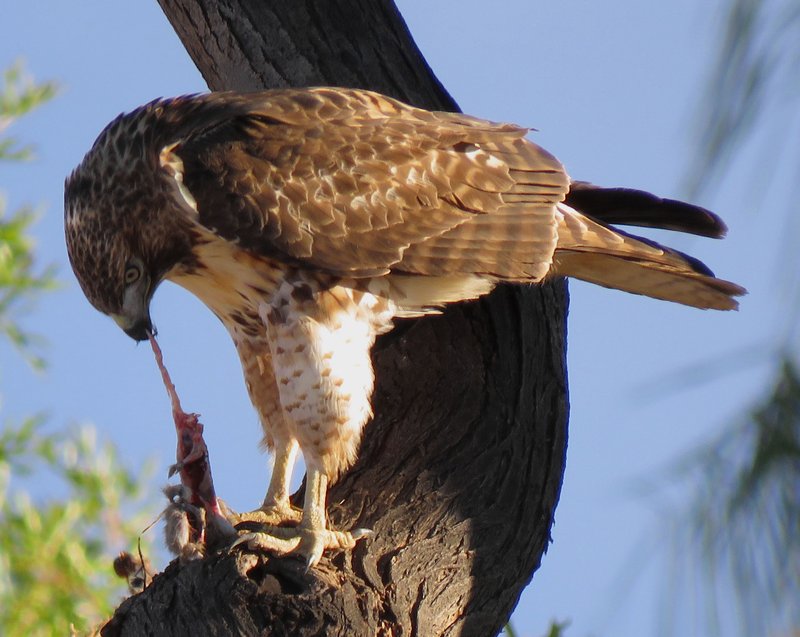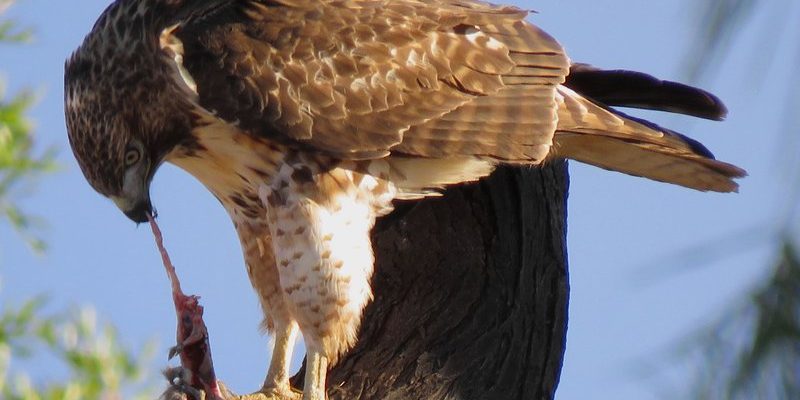
Diet of the Red-Tailed Hawk
The red-tailed hawk has a diverse diet, mainly consisting of small mammals, birds, and even reptiles. Think of it as a generalist—one that adapts its menu based on what’s available in its surroundings. Common meal choices include:
- Rodents, such as mice and voles
- Small birds, like sparrows and starlings
- Rabbits and hares
- Reptiles, particularly snakes and lizards
Honestly, these birds are skilled hunters, and they often hunt alone. If you’re out walking in the wild, you might see one perched on a telephone pole or tree branch, looking for its next meal. Their sharp talons and hooked beaks make them truly efficient predators, allowing them to grab and consume prey quickly.
You might be wondering how the seasonal changes affect their diet. Well, during winter, when small mammals like voles are harder to find, red-tailed hawks might switch to eating more birds. This flexibility is key to their survival.
Hunting Techniques
Red-tailed hawks are known for their remarkable hunting skills. They use a combination of keen eyesight and patience to catch their prey. Picture this: a hawk sitting still, almost like a statue, waiting for the perfect moment to strike.
These birds usually hunt from a high vantage point, such as a tree branch or a rock outcrop. From there, they can scan the ground below for any signs of movement. Once they spot potential prey, they launch into action. Their speed and agility are impressive. They can dive at high speeds, which helps them catch quick-moving critters.
Another common technique is called still-hunting. In this method, the hawk flies low and slowly, scanning the ground as it moves. This can be particularly effective in areas with dense vegetation, as it allows them to sneak up on unsuspecting animals.
The Role of Sight and Sound
The red-tailed hawk’s senses are finely tuned for hunting. Their eyesight is one of the best in the animal kingdom. Imagine being able to see a mouse from a quarter of a mile away—that’s how sharp their vision is! This ability is crucial for spotting prey while soaring at great heights.
But it’s not just about sight. Their keen sense of hearing also plays a role in hunting. If a hawk hears rustling in the grass, it could be a sign of hiding prey. They have a unique way of combining both sight and sound to ensure they don’t miss out on a meal.
You might find it interesting that red-tailed hawks can also communicate with each other through a series of cries. These calls can alert other hawks to potential food sources or warn them of danger. It’s almost like they have their own little network of information sharing!
Foraging Habits
While hunting is a significant part of a red-tailed hawk’s life, they also engage in foraging. This means they look for food without actively hunting it down. For instance, you might see them rummaging through the underbrush for small rodents that they can catch easily.
During this time, they might also scavenge on carrion—leftover carcasses from other animals. Think of them as opportunistic eaters; if they can grab an easy meal without the effort of hunting, why not? This behavior is common, especially in harsh weather conditions when food is scarce.
Also, red-tailed hawks often adapt their foraging to suit the time of year and local conditions. So, if one area appears overhunted or heavily populated by humans, they might move elsewhere to search for food. Their adaptability is a big reason they’re found across much of North America.
Importance in Ecosystems
Red-tailed hawks play a vital role in their ecosystems. As top predators, they help control the populations of small mammals and birds. This balance is essential for maintaining healthy wildlife communities. When their population remains steady, it can indicate a healthy ecosystem.
By keeping the numbers of smaller animals in check, red-tailed hawks prevent overgrazing, which can lead to habitat destruction. They’re like nature’s check-and-balance system, ensuring that no single species becomes too dominant.
Also, these hawks contribute to the food chain in many ways. Their presence attracts other predators and scavengers who benefit from leftover prey. This interconnectedness shows just how essential they are to their environment.
Conservation and Challenges
Like many wild animals, red-tailed hawks face challenges. Habitat destruction due to urban development and agricultural expansion can limit their hunting and foraging areas. Additionally, disturbances, such as chemical exposure or collisions with vehicles, pose risks.
Conservation efforts are vital to ensure these magnificent birds continue to thrive. Protecting their habitats and minimizing human impact can go a long way in supporting their populations.
You can contribute simply by spreading awareness about these birds and supporting local conservation programs. It’s a small step that can lead to huge benefits for the red-tailed hawk and the ecosystems they inhabit.
Final Thoughts
Understanding what the red-tailed hawk eats and how it hunts or forages gives us a deeper appreciation for this incredible bird. Their adaptability, hunting techniques, and roles in the ecosystem are all intertwined, making them a fascinating subject of study. Whether you’re a nature lover or just curious about wildlife, the red-tailed hawk reminds us of the beauty and complexity of nature.
So next time you spot one soaring overhead, take a moment to appreciate the skill and grace of this remarkable predator. They truly are a testament to the wonders of the natural world!

